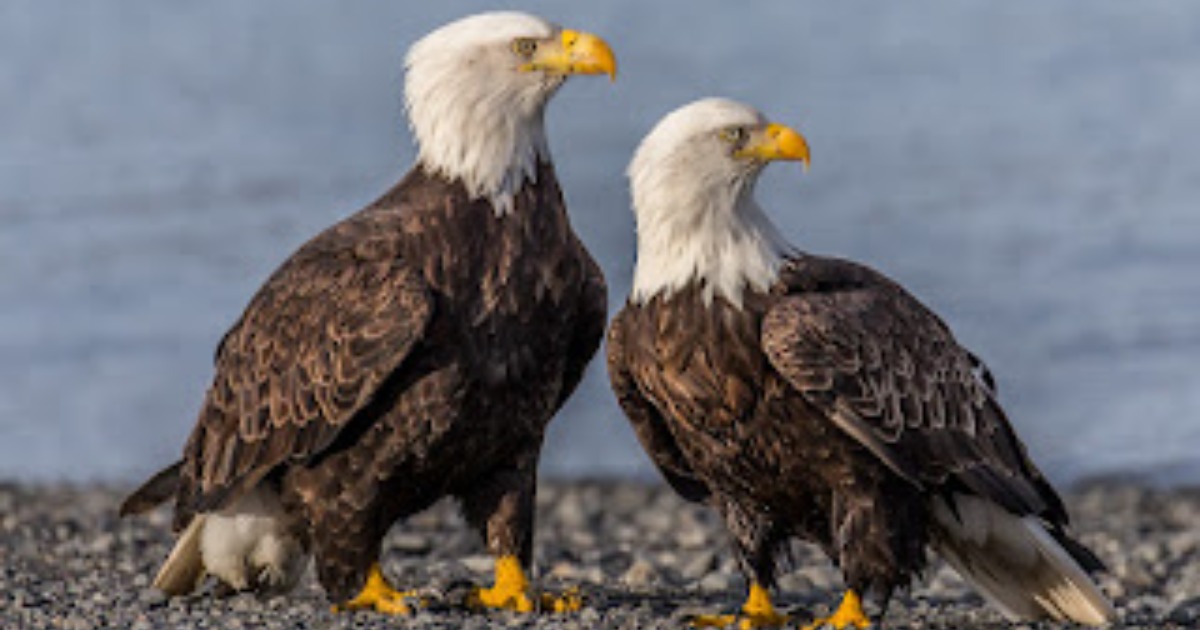Do you think an owl could defeat the great eagle?
Bald eagles and Great horned owls are constantly fighting each other, they fight over meals, houses, and even territories in North Springfield Lake in Springfield, Vermont.
If you believe the bald eagles could easily defeat their foes, think again. The founding fathers of the United States wanted a bird to represent a strong and powerful nation.
One that could soar high into the sky as a symbol of liberty As a result, they chose the bald eagle, which is only found in North America.
The most common owl in America is the Great horn owl, easily identified by its feather and tufts on its head,
To some people, these “plumicorns” look like horns or catlike ears.
What do they look like?
Bald eagles are one of the largest predators in the sky, they have a brown body, large wings, white head and tail, and a beak that is hooked yellow.
They have yellow feet that are equipped with shark black talons.
As they mature, the color of the hooked bill turns from dark brownish-black to yellow, and the head and tail still remain white.
The Bald eagle can grow to 2.5 to 3 feet (0.7 to 0.9 m). They weigh from 6.5 to 14 pounds (3 to 6.5 kilograms) with a great wingspan that reaches up to 8.5 feet (2.6 meters).
Female bald eagles are larger than males but share the same coloration.
Great Horned OWL
Great horned owls range in length from 17 – 25 inches (43 – 63 cm), have a wingspan of up to 5 feet (1.5 m), and an average weight of 3.2 pounds (1.5 kg).
Their talons form an oval between 4 – 8 inches (10 to 13 cm) in diameter.
Large eyes, great hearing, and stealthy flying are all essential for their hunting success.
Their eyes have evolved for night vision, but they are rather static and forward-directed.
Because of this, owls’ cervical vertebrae are highly flexible, allowing them to tilt their heads 180 degrees.
The great horned owl is one of the numerous owl species that have conspicuous ear tufts atop their heads.
The owl has a facial disk face that is rust-brown in color, and white feathers on both its chin and throat are apparent. Their upper body is mottled grey and brown, with a barred belly.
How do they behave in the wild?
Bald eagles mate throughout their life and they form pair bonds through an amazing and spectacular flight display.
In winter, bald eagles flock together in large groups in close proximity to where salmon come to spawn. During the breeding season, they patrol and monitor their territory.
They are known for their talon-grappling, cartwheeling fights, which are aggressive territorial disputes rather than courtship behavior.
Their territories differ widely depending on where they live, and their home ranges appear to overlap.
Large trees within a kilometer of water are usually suitable roosting locations, and it appears that sites are chosen for their height, diameter, and protection from severe weather and predators.
Great Horned Owls are most active at night, especially at twilight and early in the morning.
On occasions when food supply is low, they’ll hunt in the evening till daybreak, during winter seasons they prefer to hunt during the day.
Mate that pair with each other are monogamous and aggressively protect their territories.
especially in the winter before egg-laying and in the fall when their young leave the area.
Great Horned owls defend their territory from intruders by screams, hisses, guttural noises, and by bill-clapping.
If the threat becomes too great, they will expand their wings and strike with their feet.
Where do they live?
You can find Bald eagles in several states of the US. These eagles will also spread across northern Mexico, much of Canada, and Alaska.
The number of sightings varies according to the season. Bald eagles prefer to live near bodies of water because fish are their preferred prey.
They live in wetlands, along coastlines, around lakes and rivers, and in marshes.
Bald eagles prefer hardwoods like oak trees or coniferous trees like pine trees for perching, roosting, and nesting.
Great horned owls have the largest range of any owl species, encompassing the majority of boreal forests in North and South America, ranging from Alaska to Canada.
Southward via the United States and Mexico, northern South America, and Patagonia
Because foraging in dense forests and underbrush is challenging for owls, they prefer settings with broad clearings near residual woodlands and forest grasslands and swathes.
What do they eat?
The strong, pointed beaks of bald eagles are intended for ripping off and tearing prey into bites, and strong legs and feet are equipped with large and sharp talons designed for killing prey.
They are foragers that prefer fish as their primary source of diet and are commonly found in places where fish are abundant.
They also eat sea birds and ducks or hunt over grasslands and marshes for small mammals such as rabbits, squirrels, prairie dogs, and muskrats.
Bald eagles happily consume carcasses and are well-known for robbing prey of their meal.
Great horned owls are carnivorous birds and would devour a wide variety of prey.
These intriguing predators, like other owls, consume their prey whole and then vomit “pellets” of fur and broken bones.
They are most active at night, although have been seen in the late afternoon or early hours of the morning.
These fascinating birds like to eat rabbits and hares but will eat any tiny mammal, bird, reptile, or amphibian that comes close enough.
Bald Eagle vs Great Horned Owl?
Great Horned Owls and Bald eagles have a complex and chaotic relationship.
They constantly harass each other, kill/eat each other’s young, the battle over nests (which have always been built by the eagle), and generally just don’t like each other.
Owls are scary and skilled at stealthy killing, swooping in and scooping up their targets in the twinkling of an eye.
They rarely make a sound when they flap their wings, so if one flew above your head or perched behind you, you’d never hear it.
Despite the fact that bald eagles are substantially larger than owls, owls are known as “the tigers of the sky.”
The owls, on the other hand, make up for their small size with their ruthlessness.
Eagles are even known to attack much more powerful and more massive prey such as wolves and wild goats.
The size of the eagle’s feet, with talons, is about 1.5 bigger than the size of the owl’s deadly feet. But, pound for pound, the Great Horned is far tougher.
An owl has a stronger grip than a bald eagle that’s why it’s able to challenge it, despite the fact that the bald eagle is bigger and stronger.
Eagles hold the prey down by standing on it and rip shreds off to swallow. The prey dies in an instance from shock.
The owl, on the other hand, kills and eats differently. They usually grip and hold, then crush the rib cage with their extraordinarily strong talons, making breathing impossible.
When the prey takes a breath, the grip tightens, much like a constrictor snake. Their strength and badassery are far out of proportion to their size.
In-battle, the eagle has the advantage.
But in a nest or on the ground… if an owl gets a grip near the spine of the eagle, that would be very bad news for the eagle once the crushing begins.
So even though the eagle knows he should be able to beat the smaller Great Horned Owl, it really is a great risk that may not be worth it.
A zoo made the mistake of housing a Great Horned Owl and Bald Eagle together.
One morning, It was discovered that the Great Horned Owls had eaten the Bald Eagles and gotten fat.
In some cases, eagles are respectful enough to escape from an owl who has disturbed its nests.
Bald Eagle on the other hand can defeat a Great Horned Owl, It all depends on the individual, experience, and ruthlessness.
But when it comes right down to it, A Bald Eagle can destroy A Great Horned Owl if need be.



